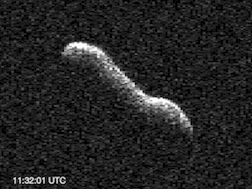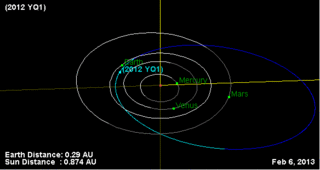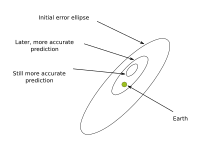The Torino scale is a method for categorizing the impact hazard associated with near-Earth objects (NEOs) such as asteroids and comets. It is intended as a communication tool for astronomers and the public to assess the seriousness of collision predictions, by combining probability statistics and known kinetic damage potentials into a single threat value. The Palermo Technical Impact Hazard Scale is a similar, but more complex scale. Near-Earth objects with a Torino scale of 1 are discovered several times a year, and may last a few weeks until they have a longer observation arc that eliminates any possibility of a collision. The highest rating ever assigned on the Torino Scale was given to the asteroid 99942 Apophis, which had a rating of 4 for four days in late 2004.

Sentry is a highly automated impact prediction system operated by the JPL Center for NEO Studies (CNEOS) since 2002. It continually monitors the most up-to-date asteroid catalog for possibilities of future impact with Earth over the next 100+ years. Whenever a potential impact is detected it will be analyzed and the results immediately published by the Center for Near-Earth Object Studies. However, several weeks of optical data are not enough to conclusively identify an impact years in the future. By contrast, eliminating an entry on the risk page is a negative prediction.

2007 VK184 is a sub-kilometer asteroid, classified as a near-Earth object of the Apollo group, and estimated to be approximately 130 meters (430 ft) in diameter. It was listed on the Sentry Risk Table with a Torino Scale rating of 1 for a potential impactor in June 2048. It was removed from the Sentry Risk Table on 28 March 2014.
1994 WR12 is an asteroid and near-Earth object approximately 130 meters (430 feet) in diameter. As a member of the Aten group almost all of its orbit is closer to the Sun than Earth is. On 24 November 1994 it passed about 374100 km from the Moon. First imaged at Kitami Observatory on 26 November 1994, it was discovered two nights later by American astronomer Carolyn S. Shoemaker at Palomar Observatory on 28 November 1994. The asteroid then went unobserved from 1994 until it was recovered by Mauna Kea in March 2016. It was removed from the Sentry Risk Table on 2 April 2016.

(367789) 2011 AG5, provisional designation 2011 AG5, is a sub-kilometer asteroid, classified as near-Earth object and potentially hazardous asteroid of the Apollo group. It has a diameter of about 140 meters (460 ft). It was removed from the Sentry Risk Table on 21 December 2012 and as such it now has a rating of 0 on the Torino Scale. It was recovered in December 2022 extending the observation arc from 4.8 years to 14 years. As of 2023, the distance between the orbits of Earth and 2011 AG5 is 0.0004 AU (60,000 km; 0.16 LD)

2012 YQ1 is a sub-kilometer asteroid, classified as a near-Earth object and a potentially hazardous asteroid of the Apollo group, approximately 200 meters in diameter. It was first observed on 19 December 2012, by astronomers Andrey Oreshko and Timur Kryachko at the Elena Remote Observatory (G32) located in the Chilean Atacama desert.
2012 KP24 (also written 2012 KP24) is a Chelyabinsk-sized near-Earth asteroid with an observation arc of only 5 days and has a modestly determined orbit for an object of its size. Around 31 May 2023 ±3 days it will pass between 0.19–24 lunar distances (73,000–9,200,000 km) from Earth. Nominally the asteroid is expected to pass 0.026 AU (3,900,000 km; 10 LD) from Earth and brighten to around apparent magnitude 21.6.
(163132) 2002 CU11, provisional designation 2002 CU11, is a bright, sub-kilometer asteroid, classified as near-Earth object and potentially hazardous asteroid of the Apollo group. Based on absolute magnitude, it is the second largest asteroid known to have passed closer than the Moon.
2014 XL7 is a near-Earth object and Apollo asteroid, approximately 230 meters (750 feet) in diameter. It was the most dangerous potentially hazardous asteroid on Sentry Risk Table upon its discovery by the Mount Lemmon Survey in December 2014. At the time, the asteroid had a cumulative 1 in 83000 chance of impacting Earth on 4–5 June between the years 2048 and 2084. After the object's observation arc had been extended to 35 days, it was removed from the Sentry Risk Table on 15 January 2015. Since then the asteroid's orbit has been secured. Although it has an Earth minimum orbit intersection distance of less than one lunar distance, there are no projected close encounters with Earth in the foreseeable future, with its closest passage to occur in May 2046, still millions of kilometers away.
2013 TX68 is an Apollo asteroid and near-Earth object discovered on 6 October 2013 by the Catalina Sky Survey, during which it was near a close approach of 5.4 Lunar distances (LD) from the Earth. The asteroid only has a 10-day observation arc which makes long-term predictions of its position less certain. It was observed for three days as it approached Earth in the night sky starting with the sixth of October, 2013. Then it became unobservable by being between the Earth and the Sun, then not recovered due to its small size and dimness. Precovery images by Pan-STARRS from 29 September 2013 were announced on 11 February 2016 that extended the observation arc to 10 days. It was removed from the Sentry Risk Table on 11 February 2016, so there is no risk of impact from this object for the next hundred years or more. The asteroid was last observed on 9 October 2013.
(585310) 2017 YZ1, provisional designation: 2017 YZ1, is a sub-kilometer asteroid on an eccentric orbit, classified as near-Earth object and potentially hazardous asteroid of the Apollo group, approximately 250 meters (800 feet) in diameter. It was first observed on 20 December 2017, by astronomers with the Mount Lemmon Survey at Mount Lemmon Observatory near Tucson, Arizona, in the United States. On 29 January 2018, it passed Earth at 125 lunar distances.
2010 GZ60 was originally estimated by JPL to be a near-Earth asteroid approximately 2 kilometers (1.2 miles) in diameter. But is now known to be an asteroid from the inner region of the asteroid belt that does not get closer than 1.5 AU (220 million km) to Earth.

2017 XO2, also written 2017 XO2, is a sub-kilometer asteroid and near-Earth object of the Apollo group approximately 110 meters (360 feet) in diameter. The asteroid was discovered by Pan-STARRS in December 2017, after it already had approached Earth at 0.051 AU (7,600,000 km) or 20 lunar distances (LD) on 6 November 2017. On 26 April 2057, it will pass Earth at a similar distance of 21 LD again.

2018 XB4 (also written 2018 XB4) is an Apollo near-Earth asteroid roughly 53 meters (170 feet) in diameter. It was discovered on 13 December 2018 when the asteroid was about 0.125 AU (18,700,000 km; 11,600,000 mi) from Earth and had a solar elongation of 146°. It passed closest approach to Earth on 1 January 2019. Of the asteroids discovered in 2018, it had the highest Palermo scale rating at –3.6. In mid-2019 it was recovered which extended the observation arc to 177 days and was removed from the Sentry Risk Table on 12 June 2019. It is now known that on 22 June 2092 the asteroid will pass about 0.033±0.015 AU from Earth.

2006 QV89 (also written 2006 QV89) is an Apollo near-Earth asteroid roughly 30 meters (100 feet) in diameter. It was discovered on 29 August 2006 when the asteroid was about 0.03 AU (4,500,000 km; 2,800,000 mi) from Earth and had a solar elongation of 150 degrees.
2018 VP1 is an Apollo near-Earth asteroid roughly 2 meters (7 feet) in diameter. The asteroid had a 0.41% chance (1 in 240) of impacting Earth on 2 November 2020 01:12 UT. It was discovered on 3 November 2018 when it was about 0.003 AU (450,000 km; 280,000 mi) from Earth and had a solar elongation of 165 degrees. The asteroid has a short 12.9 day observation arc. It was last observed on 16 November 2018 by the European Southern Observatory Very Large Telescope at apparent magnitude 26 pushing the telescope close to the limiting magnitude.
2022 AE1 is a Tunguska event-sized asteroid, classified as a near-Earth object of the Apollo group, approximately 70 meters (230 feet) in diameter. It was discovered by the Mount Lemmon Survey on 6 January 2022, when it was 0.09 AU (13 million km) from Earth. On 9 January 2022 with an observation arc of 3 days, it was rated with a Torino scale of 1 for a virtual impactor on 4 July 2023 16:28 UTC. Nominal approach is expected to occur 1 July 2023 01:13 ± 1 day. With a Palermo scale rating of as high as –0.66 at the European Space Agency on 11 January 2022, the odds of impact peaked at about 4.6 times less than the background hazard level. NEODyS was the first risk-page to drop to Torino scale 0 on 12 January 2022 followed by ESA on 13 January 2022, but by January 14 both returned to Torino scale 1. On 14 January 2022 the waxing gibbous moon was as little as 3 degrees from the asteroid delaying observations of the asteroid from January 12–19. On 20 January 2022 with a 16-day observation arc, using JPL #11 the Sentry Risk Table dropped the asteroid to Torino scale 0 and then later that day JPL #12 resulted in it being removed from the risk table.
2022 BX1 is a potentially hazardous asteroid around 200 meters in diameter that was discovered on 25 January 2022 when it was 0.36 AU (54 million km) from Earth. On 29 January 2022 with an observation arc of 22 days it was rated with a Torino scale of 1 for a virtual impactor on 11 July 2061 21:22 UTC. The 2061 virtual impactor was ruled out on 9 February 2022 with a 32.9 day observation arc. Nominal approach is expected to occur 18 June 2061.

2023 DZ2 is an asteroid roughly 70 meters in diameter, classified as a near-Earth object of the Apollo group, and originally a Virtual Impactor (VI). It was first observed on 27 February 2023, when it was 0.11 AU (16 million km) from Earth, with the Isaac Newton Telescope by Ovidiu Vaduvescu, Freya Barwell, and Kiran Jhass (ING and University of Sheffield student support astronomers) within the EURONEAR project. It passed 174,644 ± 0.9 km (108,518.75 ± 0.56 mi) of Earth on March 25, 2023. This is a little less than half the distance to the Moon. This was the largest asteroid to approach this close since 2019 OK. On March 21, 2023 with a 66-day observation arc, it was removed from the Sentry Risk Table. Due to the highly precise radar observations on 25 March 2023 we know that the 2004 Earth approach was closer than the 2023 approach.
2023 GQ2 is an asteroid roughly 400 meters in diameter, classified as a near-Earth object and potentially hazardous object of the Apollo group. It was first discovered on 12 April 2023, when it was 1.3 AU (190 million km) from Earth, with the Bok Telescope at Kitt Peak National Observatory. On 19 April 2023, with an observation arc of 6.7 days, it was rated 1 on the Torino scale for a virtual impactor on 16 November 2028 at 00:58 UTC. When it had a Palermo scale rating of –0.70, the odds of impact were about 5 times less than the background hazard level and this gave the asteroid one of the highest Palermo scale ratings ever issued. On 20 April 2023 precovery images from May 2019 were announced extending the observation arc to 3.9 years, and the 2028 virtual impactor was removed from the Sentry Risk Table. It is now known the nominal approach will safely occur about 13 hours after the impact scenario on 16 November 2028 13:36 ± 40 minutes.













